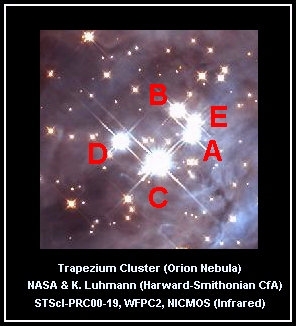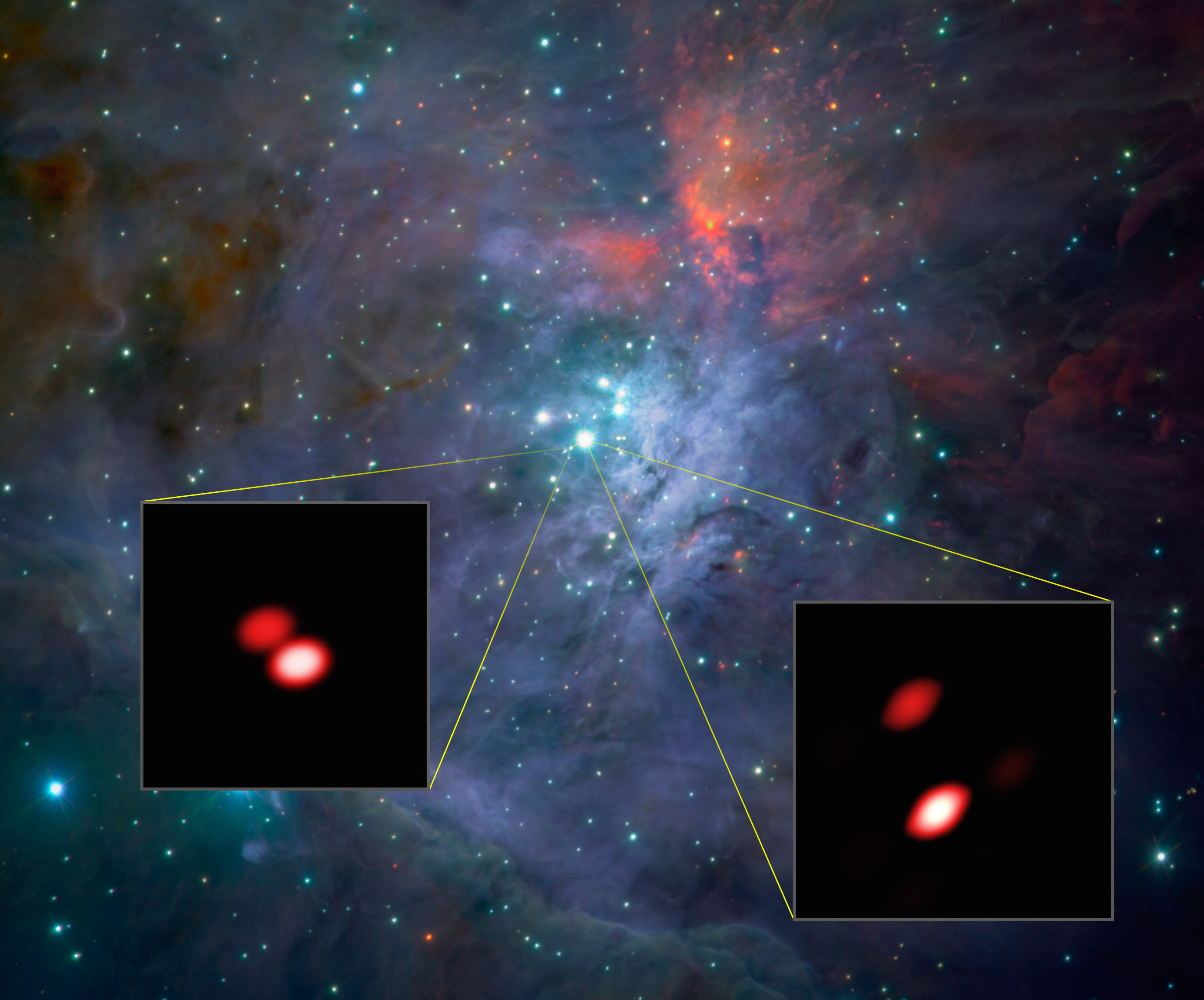|
╬Ş Orionis
The Bayer designation ╬Ş Orionis (Theta Orionis) is shared by several astronomical objects, located near RA DEC : * ╬Ş1 Orionis (41 Orionis), the Trapezium Cluster, an open star cluster, the ''Orion OB Association 1d'' ** ╬Ş1 Orionis A (41 Orionis A, HD 37020, V1016 Orionis), a trinary star system ** ╬Ş1 Orionis B (41 Orionis B, HD 37021), a quintet star system *** ╬Ş1 Orionis B West (COUP 766, MAX 97), an astronomical X-ray source *** ╬Ş1 Orionis B East (COUP 778, MAX 101), an astronomical X-ray source ** ╬Ş1 Orionis C (41 Orionis C, HD 37022), a binary star system ** ╬Ş1 Orionis D (41 Orionis D, HD 37023), a B0.5Vp variable star ** ╬Ş1 Orionis E (COUP 732), a spectroscopic binary star system ** ╬Ş1 Orionis F, a B8 variable star at 11th magnitude ** ╬Ş1 Orionis G (COUP 826, MAX 116), a young stellar object ** ╬Ş1 Orionis H (COUP 746, MAX 87), a young stellar object * ╬Ş2 Orionis (43 Orionis) ** ╬Ş2 Orionis A (43 Orionis, HD 37041), a spectroscopic trinary ** ╬Ş2 Orionis ... [...More Info...] [...Related Items...] OR: [Wikipedia] [Google] [Baidu] |
Bayer Designation
A Bayer designation is a stellar designation in which a specific star is identified by a Greek or Latin letter followed by the genitive form of its parent constellation's Latin name. The original list of Bayer designations contained 1,564 stars. The brighter stars were assigned their first systematic names by the German astronomer Johann Bayer in 1603, in his star atlas ''Uranometria''. Bayer catalogued only a few stars too far south to be seen from Germany, but later astronomers (including Nicolas-Louis de Lacaille and Benjamin Apthorp Gould) supplemented Bayer's catalog with entries for southern constellations. Scheme Bayer assigned a lowercase Greek letter (alpha (╬▒), beta (╬▓), gamma (╬│), etc.) or a Latin letter (A, b, c, etc.) to each star he catalogued, combined with the Latin name of the star's parent constellation in genitive (possessive) form. The constellation name is frequently abbreviated to a standard three-letter form. For example, Aldebaran in the constellation ... [...More Info...] [...Related Items...] OR: [Wikipedia] [Google] [Baidu] |
Right Ascension
Right ascension (abbreviated RA; symbol ) is the angular distance of a particular point measured eastward along the celestial equator from the Sun at the March equinox to the (hour circle of the) point in question above the earth. When paired with declination, these astronomical coordinates specify the location of a point on the celestial sphere in the equatorial coordinate system. An old term, ''right ascension'' ( la, ascensio recta), "''Ascensio recta'' Solis, stell├Ž, aut alterius cujusdam signi, est gradus ├Žquatorus cum quo simul exoritur in sph├Žra recta"; roughly translated, "''Right ascension'' of the Sun, stars, or any other sign, is the degree of the equator that rises together in a right sphere" refers to the ''ascension'', or the point on the celestial equator that rises with any celestial object as seen from Earth's equator, where the celestial equator intersects the horizon at a right angle. It contrasts with ''oblique ascension'', the point on the celestial ... [...More Info...] [...Related Items...] OR: [Wikipedia] [Google] [Baidu] |
Declination
In astronomy, declination (abbreviated dec; symbol ''╬┤'') is one of the two angles that locate a point on the celestial sphere in the equatorial coordinate system, the other being hour angle. Declination's angle is measured north or south of the celestial equator, along the hour circle passing through the point in question. The root of the word ''declination'' (Latin, ''declinatio'') means "a bending away" or "a bending down". It comes from the same root as the words ''incline'' ("bend foward") and ''recline'' ("bend backward"). In some 18th and 19th century astronomical texts, declination is given as ''North Pole Distance'' (N.P.D.), which is equivalent to 90 ÔÇô (declination). For instance an object marked as declination Ôłĺ5 would have an N.P.D. of 95, and a declination of Ôłĺ90 (the south celestial pole) would have an N.P.D. of 180. Explanation Declination in astronomy is comparable to geographic latitude, projected onto the celestial sphere, and right ascension is like ... [...More Info...] [...Related Items...] OR: [Wikipedia] [Google] [Baidu] |
Trapezium Cluster
The Trapezium or Orion Trapezium Cluster, also known by its Bayer designation of Theta1 Orionis, is a tight open cluster of stars in the heart of the Orion Nebula, in the constellation of Orion. It was discovered by Galileo Galilei. On 4 February 1617 he sketched three of the stars ( A, C and D), but missed the surrounding nebulosity.Galileo Galilei: Siderius Nuncius, Venice, 1610. English Translation published at Bard College, Hudson NY" October 9, 2003 English TranslatioOriginal Latin versio/ref>Tom Pope and Jim Mosher: Galilean telescope homepage" March 17, 2006 , "Some have expressed puzzlement that in his text Galileo does not mention the nebulosity (known in modern nomenclature as M42) enveloping these stars. ... Galileo believed, as he explains in ''Sidereus Nuncius'', that what looks nebulous to the eye is resolved into stars by his telescope; what looks nebulous through his telescope could presumably also be resolved into stars by a still larger and more powerful tele ... [...More Info...] [...Related Items...] OR: [Wikipedia] [Google] [Baidu] |
Theta1 Orionis A
Theta1 Orionis A (╬Ş1 Ori A) is a variable trinary star in the constellation Orion. Its apparent magnitude range is 6.72 to 7.65 with a period of 65.432 days. It is one of the main stars in The Trapezium in Orion, along with B, C, and D, as well as the fainter E. Variability ╬Ş1 Orionis A varies in brightness, showing dips from magnitude 6.72 to 7.65 every 65.432 days. These are caused by eclipses of a close binary pair. ╬Ş1 Orionis A has been assigned the variable star designation V1016 Orionis. System ╬Ş1 Orionis A is a star system with three known members. Components A1 and A2 are separated by around 0.2 ", while A1 is itself a spectroscopic binary with two stars separated by about 1 au. ╬Ş1 Orionis A1 is an eclipsing binary but the secondary is not detected in the spectrum and is far less luminous than the primary. The secondary has been proposed to be a T Tauri star, possibly of spectral class A. The orbit is not well-defined but appea ... [...More Info...] [...Related Items...] OR: [Wikipedia] [Google] [Baidu] |
Theta1 Orionis B
Theta1 Orionis B (╬Ş1 Orionis B), also known as BM Orionis, is a multiple star system containing at least five members. It is also one of the main stars of the Trapezium Cluster, with the others being A, C, and D. The primary is an eclipsing variable and one of the youngest known eclipsing binary systems. Variability ╬Ş1 Orionis B varies in brightness and has been given the variable star designation BM Orionis. Every 6.47 days, it drops from magnitude 7.90 to a minimum of magnitude 8.65 for 8ÔÇô9 hours. It was quickly classified as an eclipsing variable showing total eclipses of the brighter component, an Algol-type variable. In between the primary eclipses, there are slight brightness variations attributed to reflection effects, and a shallow secondary eclipse of less than a tenth of a magnitude. Although the light curve appears straightforward, it shows variations in the shape of the eclipse from cycle to cycle and the properties of the eclipsing componen ... [...More Info...] [...Related Items...] OR: [Wikipedia] [Google] [Baidu] |
Theta1 Orionis C
Theta1 Orionis C (╬Ş1 Orionis C) is a member of the Trapezium open cluster that lies within the Orion Nebula. The star ''C'' is the most massive of the four bright stars at the heart of the cluster. It is an O class blue main sequence star with a B-type main sequence companion. Its high luminosity and large distance (about 1,500 light years) give it an apparent visible magnitude of 5.1. Theta1 Orionis consists of multiple components, primarily the four stars of the Trapezium cluster, all within one arc-minute of each other. Theta2 Orionis is a more distant grouping of three main stars plus several fainter companions, 1-2 arc-minutes from Theta1. Theta1 C is itself a binary of two massive stars, C1 and C2, plus a very close fainter companion apparently escaping the system. Theta1 Orionis C1 is responsible for generating most of the ultraviolet light that is slowly ionizing (and perhaps photoevaporating) the Orion Nebula. This UV light is also the primary cause of ... [...More Info...] [...Related Items...] OR: [Wikipedia] [Google] [Baidu] |
Theta1 Orionis D
Theta1 Orionis D (╬Ş1 Orionis D) is a member of the Trapezium open cluster that lies within the Orion Nebula. It is a B class blue main sequence star with several faint companions. ╬Ş1 Orionis consists of multiple components, primarily the four stars of the Trapezium cluster ( A, B, C, and D) all within one arc-minute of each other. ╬Ş2 Orionis is a more distant grouping of three main stars plus several fainter companions, 1-2 arc-minutes from ╬Ş1. ╬Ş1 D itself has a faint optical companion 1.4" away and a spectroscopic companion in a 40-day orbit. Infrared Optical Telescope Array observations suggest another companion at 18.6 mas. References {{DEFAULTSORT:Theta1 Orionis D Orionis, Theta1, D Orionis, 41, D Orion (constellation) B-type main-sequence stars 037023 1896 Events January–March * January 2 – The Jameson Raid comes to an end, as Jameson surrenders to the Boers. * January 4 – Utah is admitted as the 45th U.S. state. ... [...More Info...] [...Related Items...] OR: [Wikipedia] [Google] [Baidu] |
Theta1 Orionis E
╬Ş1 Orionis E (Latinised as Theta1 Orionis E) is a double-lined spectroscopic binary located 4' north of ╬Ş1 Orionis A in the Trapezium Cluster. The two components are almost identical pre-main-sequence stars in a close circular orbit, and they show shallow eclipses that produce brightness variations of a few tenths of a magnitude. Each component of the binary system is slightly under . Although they have a subgiant spectral classification, they are still contracting onto the main sequence and are estimated to be only about 500 million years old. It is estimated that they will reach the main sequence as smaller hotter late-B stars. The variability was first reported in 1954 and confirmed as an eclipsing binary in 2012. It has not been assigned a variable star designation In astronomy, a variable star designation is a unique identifier given to variable stars. It uses a variation on the Bayer designation format, with an identifying label (as described below) pre ... [...More Info...] [...Related Items...] OR: [Wikipedia] [Google] [Baidu] |
Theta1 Orionis F
The Trapezium or Orion Trapezium Cluster, also known by its Bayer designation of Theta1 Orionis, is a tight open cluster of stars in the heart of the Orion Nebula, in the constellation of Orion. It was discovered by Galileo Galilei. On 4 February 1617 he sketched three of the stars ( A, C and D), but missed the surrounding nebulosity.Galileo Galilei: Siderius Nuncius, Venice, 1610. English Translation published at Bard College, Hudson NY" October 9, 2003 English TranslatioOriginal Latin versio/ref>Tom Pope and Jim Mosher: Galilean telescope homepage" March 17, 2006 , "Some have expressed puzzlement that in his text Galileo does not mention the nebulosity (known in modern nomenclature as M42) enveloping these stars. ... Galileo believed, as he explains in ''Sidereus Nuncius'', that what looks nebulous to the eye is resolved into stars by his telescope; what looks nebulous through his telescope could presumably also be resolved into stars by a still larger and more powerful te ... [...More Info...] [...Related Items...] OR: [Wikipedia] [Google] [Baidu] |






